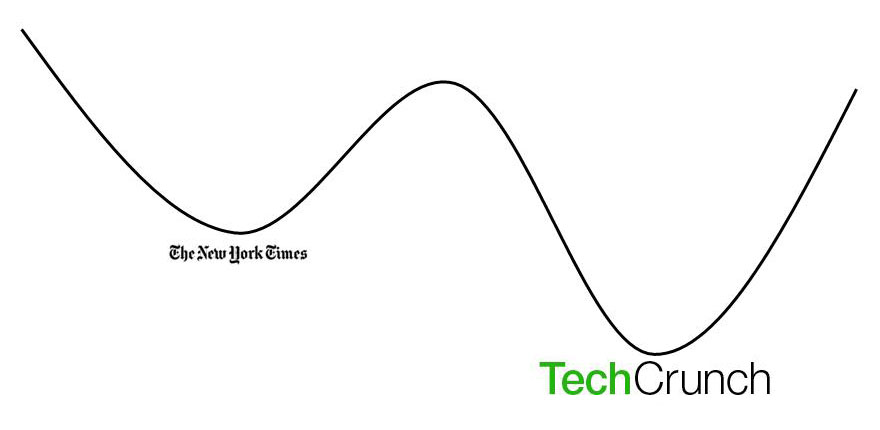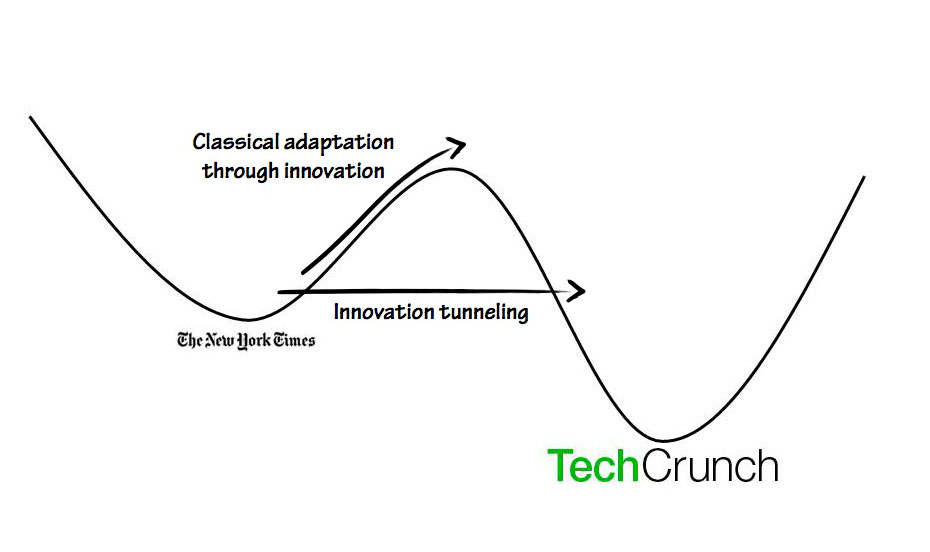A couple of days ago, @michael_nielsen posted a thoughtful article on his blog tackling rapid and disruptive changes in the scientific publishing business – especially the challenge of overcoming organizational immune systems that actively obstruct change and adaptation. Reading through the piece, I was particularly struck by his conceptualization of the barriers to change faced by established organizations. He used a neat piece of physics-speak – “local optima” – to describe the inevitable isolation businesses face when the price of change simply becomes too great for them to compete with emerging enterprises. But what really intrigued me is how, by turning this analogy on its head and talking about potential wells rather than local optima, a new approach to surviving disruptive change could be conceived – innovation tunneling…
Michael uses a comparison between the New York Times and TechCrunch to explain the problem:
A good example is the popular technology blog TechCrunch, by most measures one of the top 100 blogs in the world. Started by Michael Arrington in 2005, TechCrunch has rapidly grown, and now employs a large staff. Part of the reason it’s grown is because TechCrunch’s reporting is some of the best in the technology industry, comparable to, say, the technology reporting in the New York Times. Yet whereas the New York Times is wilting financially, TechCrunch is thriving, because TechCrunch’s operating costs are far lower, per word, than the New York Times. The result is that not only is the audience for technology news moving away from the technology section of newspapers and toward blogs like TechCrunch, the blogs can undercut the newspaper’s advertising rates. This depresses the price of advertising and causes the advertisers to move away from the newspapers.
Unfortunately for the newspapers, there’s little they can do to make themselves cheaper to run. To see why that is, let’s zoom in on just one aspect of newspapers: photography. If you’ve ever been interviewed for a story in the newspaper, chances are a photographer accompanied the reporter. You get interviewed, the photographer takes some snaps, and the photo may or may not show up in the paper. Between the money paid to the photographer and all the other costs, that photo probably costs the newspaper on the order of a thousand dollars. When TechCrunch or a similar blog needs a photo for a post, they’ll use a stock photo, or ask their subject to send them a snap, or whatever. The average cost is probably tens of dollars. Voila! An order of magnitude or more decrease in costs for the photo.
Here’s the kicker. TechCrunch isn’t being any smarter than the newspapers. It’s not as though no-one at the newspapers ever thought “Hey, why don’t we ask interviewees to send us a polaroid, and save some money?” Newspapers employ photographers for an excellent business reason: good quality photography is a distinguishing feature that can help establish a superior newspaper brand. For a high-end paper, it’s probably historically been worth millions of dollars to get stunning, Pulitzer Prizewinning photography. It makes complete business sense to spend a thousand dollars per photo.
What can you do, as a newspaper editor? You could fire your staff photographers. But if you do that, you’ll destroy the morale not just of the photographers, but of all your staff. You’ll stir up the Unions. You’ll give a competitive advantage to your newspaper competitors. And, at the end of the day, you’ll still be paying far more per word for news than TechCrunch, and the quality of your product will be no more competitive.
The problem is that your newspaper has an organizational architecture which is, to use the physicists’ phrase, a local optimum. Relatively small changes to that architecture – like firing your photographers – don’t make your situation better, they make it worse. So you’re stuck gazing over at TechCrunch, who is at an even better local optimum, a local optimum that could not have existed twenty years ago:
Unfortunately for you, there’s no way you can get to that new optimum without attempting passage through a deep and unfriendly valley. The incremental actions needed to get there would be hell on the newspaper. There’s a good chance they’d lead the Board to fire you.
The result is that the newspapers are locked into producing a product that’s of comparable quality (from an advertiser’s point of view) to the top blogs, but at far greater cost. And yet all their decisions – like the decision to spend a lot on photography – are entirely sensible business decisions. Even if they’re smart and good, they’re caught on the horns of a cruel dilemma.
Now, imagine Michael’s plot above turned upside down. It shows the same dilemma, but now the organizations inhabit wells – analogous to potential wells in physics – and the obstacle to competing in a disruptive market becomes a wall:
If the established organization doesn’t have the resources and capability to overcome this barrier, it will be outstripped by the new kid on the block. As Michael describes above, small or incremental changes within the organization just push it further up the barrier – things get worse rather than better initially, and the question then becomes how much bad stuff can be sustained until the barrier has been climbed and the new, more competitive state is reached.
That’s assuming that the barrier is impenetrable. But what if it could be penetrated, or tunneled through?
Turning back to physics analogies, classical physics dictates that anything in the left well would need sufficient energy to overcome the barrier in order to get over the barrier and slide into the right well. Not enough energy – no movement. But quantum physics throws a wrench in the classical works. Accepting some rather general hand waving, quantum physics says that something stuck in the left hand well has a small but finite probability of appearing in the right hand well – not by getting over the barrier, but by tunneling through it; an phenomenon know as quantum tunneling. in other words, a classically impenetrable barrier is, in fact, penetrable.
Now back to Michael’s example. Imagine that innovation is the key to overcoming the barrier between the spaces occupied by The New York Times and TechCrunch. The greater an organization’s ability to innovate, the more likely it is to classically hop over the barrier and into the adjacent well. In times of rapid and disruptive change, this will be a tall order for many organizations. But what if something like the innovation equivalent of quantum tunneling can take place – innovation tunneling?
I’m not sure how far this analogy can and should be pushed, but it’s interesting to play around with. What if innovations exist which enable established organizations to shift to a new mode of operation in the face of disruption that don’t involve taking the classical route? If they do, what would they be like, how could they be spotted and nurtured, and what would an organization look like that was able to take advantage of them?
All this seems rather hypothetical – unless this is an old phenomenon that I have simply given a new name to (highly probable given my naivety here). I’ve no idea whether this distinction between classical and non-classical innovation make sense on the ground. And I haven’t any concrete evidence for innovation tunneling. But it does strike me that if the local optimum/potential well model is right, it’s at least worth thinking about the possibility of innovation tunneling as a way of remaining competitive and riding the wave of disruptive change.
In his essay, Nielsen concludes
“it’s also clear that there are enormous opportunities to innovate, for those willing to master new technologies, and to experiment boldly with new ways of doing things. The result will be a great wave of innovation that changes not just how scientific discoveries are communicated, but also accelerates the way scientific discoveries are made.”
This has, in all honesty, been little more than an imaginative distraction on a slow afternoon, and doesn’t carry much weight intellectually. But what if innovation tunneling is one key to unlocking these opportunities for established organizations? Given the barriers Michael’s “organizational immune systems” present to surviving and adapting in a rapidly changing world, it’s probably worth the trouble to find out.




The tunneling metaphor works on many levels; let’s mine it.
Shifting to a new mode of operation can be accomplished by adopting a new business model. We have identified several archetype business model shifts including:
1. Change the Value Proposition
Bundle products and services to provide a more complete solution– GE Power by the Hour
Change the scale of the offering–Eclipse Aviation’s light regional jets
2. Change How You Deliver Value
Partner aggressively– Intel+GE recent joint foray into home health care
Build and monetize social networks –Nike
3. Change the Targeted Customer
Find unserved customers–Intuit
Find non-consumers–Tata Nano automobile
Of course there are more.
These companies tunneled their way to significantly larger and more profitable market potentials by shifting key elements of their business model.
That raises two questions: How did they do it? Why do other companies find it so hard to tunnel to the new potential in response to these leaders?
Organizational antibodies are the main reason the shift is so hard. Organizational antibodies fight change and are well developed forces that exist in every organization — the problem is that the antibodies can’t tell good change from bad change. Mitigating organizational antibodies to make the shift to a new model requires among other things, clear leadership to support the change and new performance metrics and innovation motivators. Otherwise the antibodies block and corrode the model changes and old behaviors win out.
Rob, brilliant addition to the piece – thanks. I had a friend say she couldn’t make out the tunneling stuff, until she read your comment!
I would be interested in your perspective on whether the antibody/tunneling metaphor is simply a different way of describing an established view of how businesses succeed, or whether it genuinely represents a kernel of new insight into challenges and opportunities by organizations in a rapidly changing world.
When I read Rob’s examples I immediately thought of other ways the value proposition has been changed: making personal printers highly affordable (loss leaders, almost), and making money on replacement cartridges instead; digital cameras, which require high initial investment compared with film cameras, but eliminate the processing costs (I’m thinking you can probably say the time spent digitally ‘processing’ the photos equals the time and energy it would take to drop off and pick up the rolls of film). But the best example I can come up with of this tunneling of which you speak is the HippoRoller, the device designed in part by Engineers without Borders that allows far greater quantities of water to be transported with far less physical exertion, an innovation that is truly as remarkable as the difference between travelling by horse and buggy vs by car, although it may seem only incremental and the device fulfills the same purpose as a more humble vessel like a jug or plastic handheld container.
I think the kernel of newness in this is that organizations– businesses, non-profit, government– can manage their way to new ways of doing things that used to be nearly impossible to do. It takes the right combination of leadership, culture, and processes– and never underestimate the power of organizational antibodies. More good ideas have succumbed to those devils than almost any other innovation predator. Knowing how to envision and develop the alternate a business model, manage the transition of the people, culture and processes, and mitigate the antibodies takes skill; however we have a growing body of thinking and experience on how to do it.
@Rob Don’t I know it. Sometimes those antibodies merely represent inertia. You should have seen the way people looked at me when I suggested a Speaker’s Corner for employees to have their say via video (pay $1, get to spout off, money goes to charities of employees’ choice, clips to be used in part to create internal communications TV channel) in 2001. You’d have thought I had three heads. Now I hear there’s a thing called YouTube…. 😉
Clearly a gal ahead of your time, Ruth 🙂